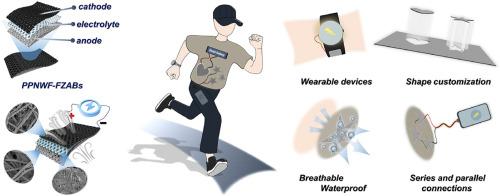Flexible, breathable and cuttable zinc-air battery textile towards real wearable energy supply clothing
IF 14.2
1区 材料科学
Q1 ENGINEERING, MULTIDISCIPLINARY
引用次数: 0
Abstract
The permeable skin electronics have recently emerged as a frontier research direction with the achievement of permeable sensors, organic transistors, and displays. However, due to the complex device structure imposed by the sophisticated electrochemical catalytic reactions, the development of breathable high-energy zinc-air batteries still remains a challenge. Herein, we successfully develop a flexible and breathable zinc-air battery based on the polypropylene nonwoven fabric (PPNWF) towards real wearable energy supply clothing. All of the battery functional components including the catalyst cathode, zinc anode, gel electrolyte and packing encapsulation are constructed on PPNWF through combined technique of plasma etching, dip-coating, electroplating and photocuring. Balance between sufficient loading of active electrochemical materials for high battery performance and reservation of excellent fabric network for good air permeability of the whole battery device is achieved. The developed zin-air battery exhibits a high open-circuit voltage of 1.44 V, a high maximum power density of 136 mW cm−2, a large specific capacity of 806 mAh g−1 at 2 mA cm−2, and a long cycling lifetime of up to 200 h. Meanwhile, the integrated textile zinc-air battery with both breathability and waterproof property can be cut and sewed into fabric clothing in our daily life such as wristband and shirt with customized shapes and modules, capable of offering stable electric energy to power portable electronics such as digital display and phone.

灵活、透气、可切割的锌空气电池织物,走向真正的可穿戴能源供给服装
近年来,随着可渗透传感器、有机晶体管、显示器等技术的发展,可渗透皮肤电子技术已成为一个前沿研究方向。然而,由于复杂的电化学催化反应所带来的器件结构复杂,可呼吸高能锌空气电池的开发仍然是一个挑战。在此,我们成功地开发了一种基于聚丙烯非织造布(PPNWF)的柔性透气锌空气电池,用于真正的可穿戴能源供应服装。采用等离子体刻蚀、浸涂、电镀、光固化等工艺,在PPNWF上构建了催化剂阴极、锌阳极、凝胶电解质、填料封装等电池功能部件。实现了活性电化学材料的充分负载以获得较高的电池性能和保留优良的织物网络以获得整个电池装置良好的透气性之间的平衡。所研制的锌空气电池具有1.44 V的高开路电压,136 mW cm - 2的高功率密度,2 mA cm - 2时806 mAh g - 1的大比容量,长达200 h的循环使用寿命。同时,具有透气性和防水性能的一体式纺织锌空气电池可以裁剪缝制到我们日常生活中的织物服装中,如腕带、衬衫等,具有定制的形状和模块。能够提供稳定的电能,为便携式电子产品,如数字显示器和电话供电。
本文章由计算机程序翻译,如有差异,请以英文原文为准。
求助全文
约1分钟内获得全文
求助全文
来源期刊

Composites Part B: Engineering
工程技术-材料科学:复合
CiteScore
24.40
自引率
11.50%
发文量
784
审稿时长
21 days
期刊介绍:
Composites Part B: Engineering is a journal that publishes impactful research of high quality on composite materials. This research is supported by fundamental mechanics and materials science and engineering approaches. The targeted research can cover a wide range of length scales, ranging from nano to micro and meso, and even to the full product and structure level. The journal specifically focuses on engineering applications that involve high performance composites. These applications can range from low volume and high cost to high volume and low cost composite development.
The main goal of the journal is to provide a platform for the prompt publication of original and high quality research. The emphasis is on design, development, modeling, validation, and manufacturing of engineering details and concepts. The journal welcomes both basic research papers and proposals for review articles. Authors are encouraged to address challenges across various application areas. These areas include, but are not limited to, aerospace, automotive, and other surface transportation. The journal also covers energy-related applications, with a focus on renewable energy. Other application areas include infrastructure, off-shore and maritime projects, health care technology, and recreational products.
 求助内容:
求助内容: 应助结果提醒方式:
应助结果提醒方式:


